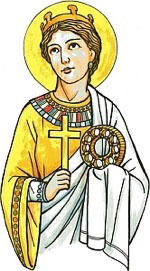We ask you, urgently: don't scroll past this
Dear readers, Catholic Online was de-platformed by Shopify for our pro-life beliefs. They shut down our Catholic Online, Catholic Online School, Prayer Candles, and Catholic Online Learning Resources essential faith tools serving over 1.4 million students and millions of families worldwide. Our founders, now in their 70's, just gave their entire life savings to protect this mission. But fewer than 2% of readers donate. If everyone gave just $5, the cost of a coffee, we could rebuild stronger and keep Catholic education free for all. Stand with us in faith. Thank you.Help Now >
Seraphim
FREE Catholic Classes
The name, a Hebrew masculine plural form, designates a special class of heavenly attendants of Yahweh's court.
In Holy Writ these angelic beings are distinctly mentioned only in Isaias's description of his call to the prophetical office ( Isaiah 6:2 sqq. ). In a vision of deep spiritual import, granted him in the Temple, Isaias beheld the invisible realities symbolized by the outward forms of Yahweh's dwelling place, of its altar, its ministers, etc. While he stood gazing before the priest's court, there arose before him an august vision of Yahweh sitting on the throne of His glory. On each side of the throne stood mysterious guardians, each supplied with six wings: two to bear them up, two veiling their faces, and two covering their feet, now naked, as became priestly service in the presence of the Almighty. His highest servants, they were there to minister to Him and proclaim His glory, each calling to the other: " Holy, holy, holy, Yahweh of hosts; all the earth is full of His glory." These were seraphim, one of which flew towards Isaias bearing a live coal which he had taken from the altar, and with which he touched and purified the Prophet's lips, that henceforth these might be consecrated to the utterances of inspiration.
Such, in substance, is Isaias's symbolical vision from which may be inferred all that Sacred Scripture discloses concerning the seraphim. Although described under a human form, with faces, hands, and feet ( Isaiah 6:2, 6 ), they are undoubtedly existing spiritual beings corresponding to their name, and not mere symbolic representations as is often asserted by advanced Protestant scholars. Their number is considerable, as they appear around the heavenly throne in a double choir and the volume of their chorus is such that the sound shakes the foundations of the palace.
They are distinct from the cherubim who carry or veil God, and show the presence of His glory in the earthly sanctuary, whilst the seraphim stand before God as ministering servants in the heavenly court. Their name too, seraphim , distinguishes them from the cherubim, although it is confessedly difficult to obtain from the single Scriptural passage wherein these beings are mentioned a clear conception of its precise meaning.
The name is oftentimes derived from the Hebrew verb saraph ("to consume with fire"), and this etymology is very probable because of its accordance with Isaiah 6:6 , where one of the seraphim is represented as carrying celestial fire from the altar to purify the Prophet's lips. Many scholars prefer to derive it from the Hebrew noun saraph , "a fiery and flying serpent", spoken of in Numbers 21:6 ; Isaiah 14:29 , and the brazen image of which stood in the Temple in Isaias's time ( 2 Kings 18:4 ); but it is plain that no trace of such serpentine form appears in Isaias's description of the seraphim. Still less probable are the views propounded of late by certain critics and connecting the Biblical seraphim with the Babylonian Sharrapu , a name for Nergal, the fire-god, or with the Egyptian griffins ( séréf ) which are placed at Beni-Hassan as guardians of graves.
The seraphim are mentioned at least twice in the Book of Enoch (lxi, 10; lxxi, 7), together with and distinctly from the cherubim. In Christian theology, the seraphim occupy with the cherubim the highest rank in the celestial hierarchy, while in the liturgy (Te Deum; Preface of the Mass) they are represented as repeating the Trisagion exactly as in Isaiah 6 .
Join the Movement
When you sign up below, you don't just join an email list - you're joining an entire movement for Free world class Catholic education.

-

- Stations of the Cross
- Easter / Lent
- 5 Lenten Prayers
- Ash Wednesday
- Living Lent
- 7 Morning Prayers
- Mysteries of the Rosary
- Litany of the Bl. Virgin Mary
- Popular Saints
- Popular Prayers
- Female Saints
- Saint Feast Days by Month
- Pray the Rosary
Stop Lying: You Don’t Represent ‘The American People’ — You Represent Your District
Easter 2025: Liberation Day – Time to Reclaim Our Faith, Our Church, and Our Future
Bishop Joseph Strickland’s Letter to President Trump: A Call for Peace in the Middle East
Daily Catholic
 Daily Readings for Monday, March 31, 2025
Daily Readings for Monday, March 31, 2025 St. Benjamin: Saint of the Day for Monday, March 31, 2025
St. Benjamin: Saint of the Day for Monday, March 31, 2025 Prayer for God's Help in Daily Actions: Prayer of the Day for Friday, March 14, 2025
Prayer for God's Help in Daily Actions: Prayer of the Day for Friday, March 14, 2025 Daily Readings for Sunday, March 30, 2025
Daily Readings for Sunday, March 30, 2025 St. Peter Regulatus: Saint of the Day for Sunday, March 30, 2025
St. Peter Regulatus: Saint of the Day for Sunday, March 30, 2025- To Perceive Animals as God's Gifts: Prayer of the Day for Thursday, March 13, 2025
![]()
Copyright 2025 Catholic Online. All materials contained on this site, whether written, audible or visual are the exclusive property of Catholic Online and are protected under U.S. and International copyright laws, © Copyright 2025 Catholic Online. Any unauthorized use, without prior written consent of Catholic Online is strictly forbidden and prohibited.
Catholic Online is a Project of Your Catholic Voice Foundation, a Not-for-Profit Corporation. Your Catholic Voice Foundation has been granted a recognition of tax exemption under Section 501(c)(3) of the Internal Revenue Code. Federal Tax Identification Number: 81-0596847. Your gift is tax-deductible as allowed by law.


 Daily Readings for Monday, March 31, 2025
Daily Readings for Monday, March 31, 2025 St. Benjamin: Saint of the Day for Monday, March 31, 2025
St. Benjamin: Saint of the Day for Monday, March 31, 2025 Prayer for God's Help in Daily Actions: Prayer of the Day for Friday, March 14, 2025
Prayer for God's Help in Daily Actions: Prayer of the Day for Friday, March 14, 2025 St. Peter Regulatus: Saint of the Day for Sunday, March 30, 2025
St. Peter Regulatus: Saint of the Day for Sunday, March 30, 2025

